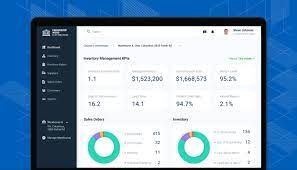Discover the Top Inventory Management Software Solutions for Your Business
The Best Inventory Management Software Solutions
In today’s fast-paced business environment, effective inventory management is crucial for businesses of all sizes. With the rise of e-commerce and global supply chains, the need for efficient inventory tracking and control has never been greater. Fortunately, there are a variety of inventory management software solutions available that can help streamline operations, improve accuracy, and boost productivity.
TradeGecko
TradeGecko is a cloud-based inventory management system that offers a range of features to help businesses manage their inventory effectively. With real-time tracking, order management, and reporting capabilities, TradeGecko is ideal for small to medium-sized businesses looking to streamline their operations.
Zoho Inventory
Zoho Inventory is another popular choice for businesses seeking an all-in-one inventory management solution. With features such as multi-channel selling, batch tracking, and warehouse management, Zoho Inventory is well-suited for e-commerce businesses looking to scale efficiently.
Fishbowl
Fishbowl is a comprehensive inventory management software that integrates seamlessly with QuickBooks. Offering advanced features such as asset tracking, barcode scanning, and manufacturing capabilities, Fishbowl is an excellent choice for businesses looking for an integrated solution.
Odoo Inventory
Odoo Inventory is a modular inventory management system that can be customised to suit the specific needs of your business. With features such as demand forecasting, cross-docking, and multi-warehouse support, Odoo Inventory is a versatile option for businesses looking for flexibility and scalability.
inFlow Inventory
inFlow Inventory is a user-friendly inventory management software designed for small businesses. With features such as sales orders, purchase orders, and reporting tools, inFlow Inventory offers an intuitive interface that makes it easy to track and manage your inventory efficiently.
Whether you are a small online retailer or a large multinational corporation, investing in the right inventory management software can help you optimise your operations and stay ahead of the competition. Consider these top solutions when choosing the best inventory management software for your business needs.
Essential Guide to Selecting Top Inventory Management Software: Key Questions Answered for UK Businesses
- What is inventory management software?
- Why is inventory management software important for businesses?
- What features should I look for in inventory management software?
- Is cloud-based inventory management software better than on-premise solutions?
- How can inventory management software help improve efficiency and productivity?
- Which industries can benefit from using inventory management software?
- What are the key factors to consider when choosing the best inventory management software for my business?
- Are there any free or open-source options available for inventory management software?
What is inventory management software?
Inventory management software is a powerful tool designed to help businesses efficiently track, control, and optimise their inventory levels and operations. It allows organisations to monitor stock levels in real-time, streamline order fulfilment processes, forecast demand accurately, and improve overall supply chain efficiency. By centralising inventory data and automating key tasks such as stock tracking, replenishment, and reporting, inventory management software enables businesses to reduce costs, minimise stockouts and overstock situations, enhance customer satisfaction, and ultimately drive business growth through better inventory control.
Why is inventory management software important for businesses?
Effective inventory management software is crucial for businesses for several reasons. Firstly, it enables businesses to maintain optimal levels of stock, preventing overstocking or stockouts that can lead to financial losses. Additionally, inventory management software provides real-time visibility into inventory levels, allowing businesses to make informed decisions regarding purchasing, production, and sales. By automating processes such as order fulfilment and tracking, inventory management software improves efficiency and reduces human error. Moreover, accurate inventory tracking helps businesses forecast demand more effectively, minimise storage costs, and enhance customer satisfaction through timely order fulfilment. Overall, investing in inventory management software is essential for businesses looking to streamline operations, improve accuracy, and ultimately boost profitability.
What features should I look for in inventory management software?
When evaluating inventory management software options, it is essential to consider key features that can enhance your business operations. Look for software that offers real-time tracking of inventory levels, allowing you to monitor stock levels accurately and prevent stockouts or overstock situations. Additionally, consider systems with robust reporting capabilities to provide insights into sales trends, product performance, and overall inventory health. Integration with other business systems such as accounting software and e-commerce platforms can streamline processes and improve efficiency. Features like barcode scanning, batch tracking, and multi-location support can also contribute to better inventory control and management. Prioritising these features when selecting inventory management software can help you optimise your supply chain processes and drive business growth.
Is cloud-based inventory management software better than on-premise solutions?
When considering the best inventory management software, a frequently asked question is whether cloud-based solutions are superior to on-premise systems. Cloud-based inventory management software offers advantages such as accessibility from any location with an internet connection, scalability to accommodate business growth, and automatic updates without the need for manual maintenance. On the other hand, on-premise solutions provide greater control over data security and customisation options tailored to specific business needs. Ultimately, the choice between cloud-based and on-premise inventory management software depends on factors like budget, IT infrastructure, and the level of control desired by the business.
How can inventory management software help improve efficiency and productivity?
Inventory management software plays a crucial role in enhancing efficiency and productivity for businesses of all sizes. By automating manual tasks such as inventory tracking, order processing, and stock replenishment, inventory management software streamlines operations and reduces the likelihood of human error. Real-time data visibility enables businesses to make informed decisions quickly, leading to better inventory control and optimised stock levels. Additionally, features like demand forecasting and reporting provide valuable insights that help businesses anticipate customer needs and plan effectively. Overall, inventory management software empowers businesses to operate more efficiently, reduce costs, and improve overall productivity.
Which industries can benefit from using inventory management software?
Various industries can benefit significantly from using inventory management software to streamline their operations and enhance efficiency. Retail businesses can improve inventory tracking, reduce stockouts, and optimise order fulfilment processes. Manufacturing companies can better manage raw materials, track work-in-progress items, and enhance production planning. Wholesale distributors can benefit from improved inventory visibility, streamlined order processing, and enhanced customer satisfaction. Additionally, industries such as healthcare, e-commerce, logistics, and hospitality can all leverage inventory management software to better manage their stock levels, reduce costs, and improve overall business performance.
What are the key factors to consider when choosing the best inventory management software for my business?
When selecting the best inventory management software for your business, several key factors should be taken into consideration to ensure that the chosen solution aligns with your specific needs and objectives. Firstly, consider the scalability of the software to accommodate your business’s growth over time. Secondly, evaluate the software’s compatibility with your existing systems and workflows to facilitate seamless integration. Additionally, assess the features offered by the software, such as real-time tracking, reporting capabilities, and user-friendly interfaces to enhance operational efficiency. Lastly, consider factors like cost-effectiveness, customer support services, and security measures to make an informed decision that will optimise your inventory management processes effectively.
Are there any free or open-source options available for inventory management software?
When it comes to inventory management software, many businesses inquire about the availability of free or open-source options. Fortunately, there are several free and open-source inventory management software solutions available that can provide robust features without the need for a significant financial investment. These options allow businesses to benefit from functionalities such as inventory tracking, order management, and reporting capabilities at no cost, making them an attractive choice for budget-conscious organisations looking to streamline their operations efficiently. By exploring these free and open-source alternatives, businesses can find a suitable inventory management solution that meets their needs without breaking the bank.




